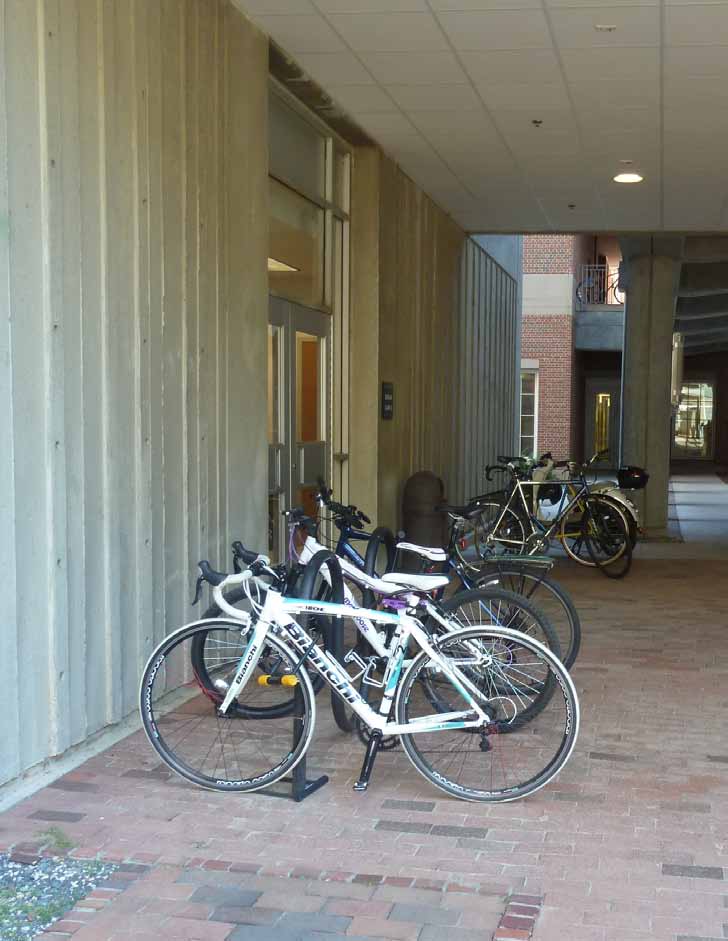Chapter 4: Engineering Recommendations – Bicycle Parking and Support Facilities
Biking should be a convenient and reliable choice, from the beginning to the end of the trip. This depends in part on the availability of bicycle support facilities such as parking, repair and maintenance resources, showers and, for some, storage facilities. The Bike Plan’s online survey revealed that many non-cyclists do not cycle because they do not want to arrive at work looking unprofessional or sweaty. Bicycle support facilities can help address that issue.
This chapter focuses on existing and proposed parking and support facilities and the policies and programs recommended to enable them.
1 Bicycle Parking Guidelines 2nd Edition is available for purchase.
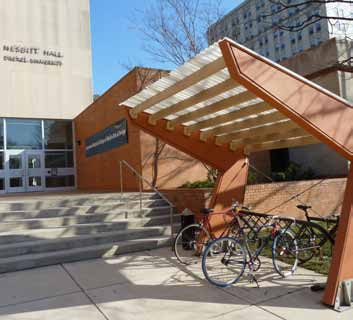
Covered bicycle parking consists of racks with some type of covering to prevent precipitation from landing on bicycles. Most often, this is a simple roof or canopy, either a separate structure constructed to cover the racks, or part of a building’s structure, such as the covered bicycle parking at Kenan Labs pictured below. Covered parking can also be located inside a parking deck. Covered parking helps prolong the life of bicycles and keeps them safer for riding by reducing their deterioration due to exposure to natural elements. Covered bicycle parking is ideal for short-term use and adequate for long-term storage.
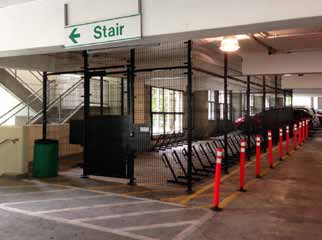
Michigan State University (MSU) and the University of California at Berkeley are two campuses with good examples of secure bicycle parking in parking decks. MSU installed a 50-bike secure parking cage and a 23-bike parking room in two of their parking decks in 2013. The cage is accessed with a university ID card and one also contains a self-service repair stand. At UC Berkeley, three secure parking areas are spread throughout campus and are accessed using a personal access code. These facilities are available only to university affiliates who have registered their bicycles.
These guidelines also govern the placement of racks with respect to other objects such as buildings, walls or tree wells. Generally, these guidelines are followed and racks are installed correctly. One example where parking was sited well is the Genome Sciences Building, where it was integrated into the courtyard design to take advantage of a covered area. There are a few exceptions where racks that are placed too close to parallel building walls do not leave sufficient space to lock a bicycle.
In some locations, racks are also located farther from the door than is desirable and not on the most direct pathway to the main entrance. Poorly planned parking leads to parking on stair and ramp railings at the building, which makes the ramps and steps less safe for use by pedestrians.
There is no secure outdoor or indoor bicycle parking on campus, though some riders keep bicycles indoors in an ad hoc manner. Providing designated indoor bicycle parking is feasible at UNC-CH since there is no prohibition on taking bicycles into buildings as long as fire and accessibility codes are not violated. Another UNC system school, UNC Wilmington, provides indoor bike parking in all new construction as part of that university’s requirement for buildings to be LEED (Leadership in Energy and Environmental Design) certified.
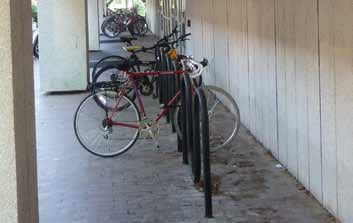
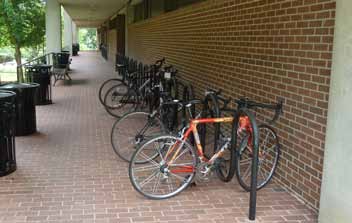
Racks near the Pit were observed to be near or at 100% capacity at midday on a weekday. Occupancy was less in the evenings. Bicycles were also locked to railings and benches in this area, encroaching into pedestrian space and preventing the use of outdoor furniture. Racks at academic buildings on and near McCorkle and Polk Places were at less than 100% occupancy on weekdays, and there were fewer bikes locked to non-rack objects in these areas.
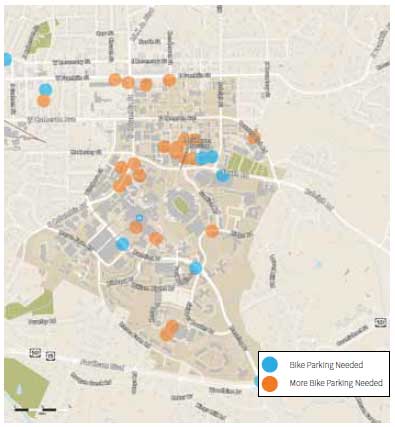
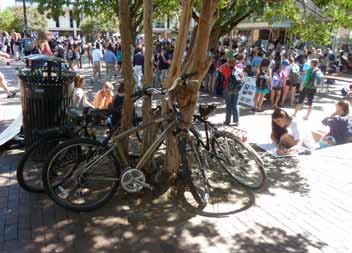
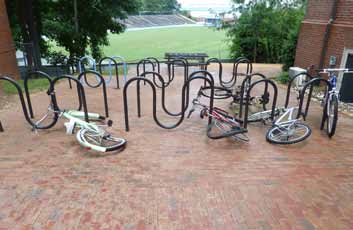
- inside a University building, where an unsafe or hazardous condition is created for building occupants;
- against or attached to any tree, bush, plant or foliage;
- against or attached to any electrical fixture, sign post, railing, public seating fixture or emergency safety device; or
- in any other area where parking is prohibited specifically by this Ordinance.
Bicycles parked in these locations are removed as they are noticed by DPS. A $10 impoundment fee may be charged to the owner to recover the bicycle. The Ordinance also specifies that it is the right of the University to impound a bicycle considered “junked, abandoned, lost/stolen, parked/stored or operated in violation of this Ordinance, or state or local fire safety regulations.”
Impounded bicycles are kept for 30 days by DPS before deemed University property. Letters are sent to owners of registered bicycles informing them of impoundment, and when an owner is unknown, notice is posted at DPS. Bicycles that become University property are auctioned annually as-is in a fundraiser for the Alpha Phi Omega service fraternity’s charity work.
Parking Supply
- Assess the need for additional racks through an annual survey of bicycle parking capacity. Support from volunteers or interns can help offset the resources needed for this survey.
- Conduct the survey in late September on a non-rainy weekday.
- Areas where parking exceeds 80% occupancy should be targeted for addition of new racks where space permits.
- Aim for parking supply according to the standards enumerated below. These figures are based on the goal of a modest increase in bicycle mode share. Results of the recommended annual parking survey should override guidance below.
- Residence halls and other University-owned student residences: Supply parking at a rate of 1 space per 7 building occupants. This is based on national standards and policies in comparable settings. Support from University Housing could be sought for this recommendation.
- For example: A 250-bed residence hall would be built with 36 bicycle spaces.
- Classroom buildings: Supply parking at a rate of 1 space per 15 seats. This is based on a 75% seat occupancy at any class time and an estimated 20% of class attendees arriving by bicycle.
- For example: A 1000-seat classroom building would be built with 150 bicycle parking spaces.
- Office buildings: Supply parking at a rate of 1 space per 10 employees. This is based on an estimated 10% of employees arriving by bicycle.
- Racks associated with a particular building should be located within 50 feet of its doorway(s) or inside the building itself.
- Residence halls and other University-owned student residences: Supply parking at a rate of 1 space per 7 building occupants. This is based on national standards and policies in comparable settings. Support from University Housing could be sought for this recommendation.
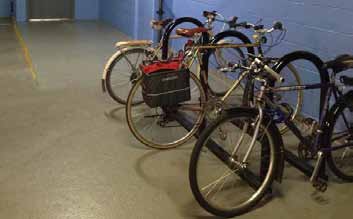
Parking Type
- Prioritize covered parking at residence halls as student bicycles are most likely to be parked on racks for extended periods of time.
- Provide academic and office buildings with short-term outdoor parking at a minimum and seek opportunities for other types of longer-term parking as described in this chapter.
Equipment Specifications 2
- Revise University design guidelines to specify the inverted U rack as the preferred type. Its strength, economy, ease of installation, ease of use and versatility in placement are major advantages over the wave rack. A single U rack accommodates two bicycles.
- Install racks according to the APBP Guidelines, and train staff on proper placement and installation techniques.
Parking in New Construction
- Require new construction on campus to provide appropriate bike parking based upon the building use per the supply guidelines above.
- Incorporate indoor bike parking into building design whenever possible. Indoor parking must be close to entrances for ease of use and to reduce conflicts with other building occupants. Underutilized spaces such as under stairways can be considered for parking, and separate bike rooms should also be considered as part of building design.
- It was observed that more parking could potentially occur under roof overhangs that afford some protection.
Retrofitting Parking
- Over time, retrofit all existing wave style racks on campus and replace with inverted U racks. The replacements will occur as funding is available and as renovation and new projects occur. Retrofitting with inverted U racks should be prioritized based on location, as measured in the annual bike parking capacity survey.
- Retrofitting existing racks is a lower priority, generally, than providing an adequate number of spaces at prioritized locations.
2 Guidance on rack spacing and placement is given in Appendix C. It is also available in the APBP guidelines.
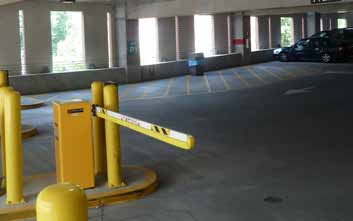
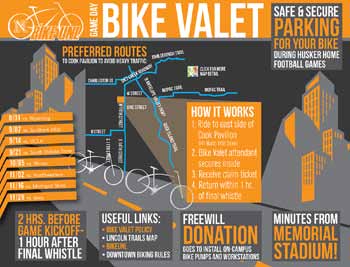
It is recommended that UNC-CH adopt an enforceable policy that keeps bike racks clear and usable. It is most important to clear bike racks near academic, office and hospital buildings, because these see the most frequent turnover.
Other campuses follow a procedure that clears bikes in high-traffic areas at least every other month during the academic year and clears abandoned bicycles from all campus racks at the end of semesters. This can be done on a rolling basis for individual sectors of campus. Abandoned bicycles can be defined as those that are not rideable (flat tires, bent wheels and missing seats, etc.) or those that have not been moved from a rack for 14 days. The following procedure is an example from Harvard University:
- Attach a tag to each bike stating that it has been deemed abandoned. Allow two weeks for the owner to move or repair the bicycle.
- Revisit racks two weeks later to impound remaining abandoned bicycles.
- Contact owners if bicycles are registered with DPS. Allow owners two weeks to claim their bicycle.
- Hold all bicycles for 30 days total after which they become University property.
This tagging and removal could be coordinated by DPS staff, and may be less costly if performed by student employees. Other universities with on-campus bike shops partner with shop staff to tag and remove bicycles. The shop also takes care of recycling bicycle parts and, in some cases, refurbishing bicycles for sale.
In addition to implementing the recreational facility shower program described above, it is recommended that the University study current shower facility use by bicycle commuters. New shower facilities were recently installed at the Genome Sciences building, and their use could be reviewed through a web survey whose link is posted at the facility. This will help determine whether showers like this should be considered for other buildings in the future. For future new buildings, the decision to provide commuter showers should be based on the proximity of that building to other shower facilities that are available to commuters.
It may be that more than one maintenance and repair option can be implemented. Whatever approach UNC-CH decides to take, student involvement in the development and implementation of the concept will be critical. Several different maintenance and repair options are described next.
Do-It-Yourself (DIY) Repair Stations
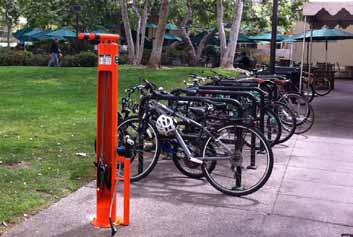
It is recommended that at least one repair station be installed on campus in the short-term. Investment in one of these stations and placement in a high-visibility location like the Pit, would send a strong message that UNC-CH supports bicyclists. A staff member or department would need to be assigned responsibility for regularly checking the station to ensure that it is in good working condition.
Mobile Repair Shop Visits
Some campuses enter into agreements with local bicycle shops to periodically visit campus and set up temporary locations for repairs. Eastern Mennonite University in Harrisonburg, Virginia works with a local mobile bicycle shop that visits campus weekly to provide repairs to students’ and employees’ bicycles. UNC-CH could contract with a vendor to provide minor bicycle repairs at no cost to students and staff and potentially arrange discounts for more significant repairs. If a bicycle is in need of major repair, the owner could take it to the vendor’s shop, possibly also for a University-arranged discount.
Additionally, the University could work with a vendor to provide a seasonal program whereby the bike shop transports bicycles to and from campus in the spring or fall, in order to perform full tune ups in preparation for the semester.
Student-Run Mobile Shop
This type of shop is largely dependent upon student interest. University of Colorado-Boulder and UNC-Greensboro both operate successful mobile mechanic programs. UNC-Greensboro pays student interns to serve as bike mechanics on an on-call basis to make small repairs.4 The advantages of the mobile set-ups is that there is minimal physical space required, students can take ownership of program operations and competition with local shops is minimal. A student-run shop presumes that there are students with mechanic skills who can perform the repairs, and that consideration is given to competition with local bike repair shops.
A student-run shop will only work if there is strong interest from a group of students who can shepherd the project through its initial stages. Tar Heel Bikes, through its bike share program, is demonstrating that this kind of student-led initiative is possible at UNC-CH.
Student-Operated Permanent Shop
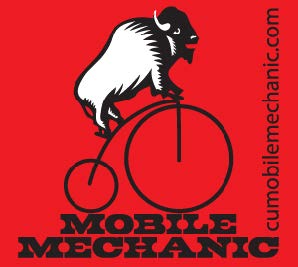
Permanent campus bicycle repair shops often become a hub of bicycle activity, and include an educational component in addition to performing bicycle repairs. The repair shop can also teach owners about how their bicycle operates and how they might fix it themselves in the future. Some student shops have a university staff manager who is a paid employee, most often from an outdoor recreation department. Both shops managed by students and those managed by staff depend upon the professionalism and dedication of student workers. The advantage of a permanent shop is that it can perform more extensive repairs, stock more parts for repair and possibly sell new and used bicycles.
As mentioned earlier, some campus shops also repair and sell bikes that were abandoned on campus. They may work with campus police departments to assess, recycle and repair abandoned bicycles and their parts. They may also operate the tagging and impounding programs for the departments. This is an important function, as the resale of abandoned bikes creates a revenue stream and the police are relieved from spending their time clearing bicycle racks of abandoned bikes.
3 Two examples of public repair stations are from Bike Fixtation and Dero.
4 The repair program is available to affiliates with registered bicycles only and is overseen by Parking Operations & Campus Access Management.
